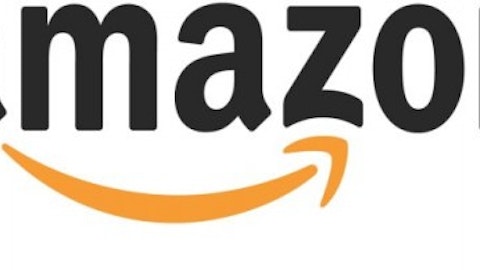Have you ever seen an empty parking lot at Wal-Mart Stores, Inc. (NYSE:WMT)? If you have never been to Wal-Mart, then there’s at least a good chance that you have driven by one. And if that’s the case, then it’s likely that you told yourself not to drive by it anymore if possible. Why? Because the store creates too much traffic. When a store creates “too much traffic,” you should be betting with it, not against it.

Some analysts have recently come out and said that they’re bearish on Wal-Mart Stores, Inc. (NYSE:WMT). One analyst even mentioned shorting Wal-Mart Stores, Inc. (NYSE:WMT) — not recommended in any way, shape, or form. Of course, there will always be short-term fluctuations, but Wal-Mart Stores, Inc. (NYSE:WMT) has done nothing but reward its investors for decades. This includes recessions. As a matter of fact, Wal-Mart Stores, Inc. (NYSE:WMT)’s stock actually appreciated in 2008. This was a rarity, especially for a retailer. This happened because middle-income consumers added to the traffic. They needed to cut costs and shop for value. Wal-Mart fit the bill. Many of those middle-income consumers still shop there today.
Wal-Mart might not be growing at a rapid rate, but it’s still growing, and that’s more than can be said for many companies throughout the broader market. Several other factors make Wal-Mart appealing.
Employees
Wal-Mart might have a reputation for treating its employees poorly, and rightfully so, but management has a different kind of focus.
Wal-Mart is all about keeping investors happy, and if you’re one of those investors, then you don’t want Wal-Mart employees to have higher wages or improved benefits. You want costs to stay low. This sounds terrible from a moral standpoint, but the purpose of this article is to educate from an investing standpoint, not a moral standpoint.
Another plus for investors is that Wal-Mart employs approximately 2.2 million people. This might not seem like a plus, but if Wal-Mart wanted to cut a portion of its workforce to cut costs and boost earnings, it could do so with ease. Wal-Mart could start with the unnecessary greeter.
Ahead of the curve
Wal-Mart wants to be ahead of industry trends. While Wal-Mart might not have a reputation as a strong online company, it’s ranked No. 34 in the United States and No. 172 globally for online traffic. Unlike most retailer websites in this weak consumer environment, Wal-Mart’s online traffic has increased over the past three months. Online traffic has also been steady for Sam’s Club.
In order to stay ahead of the technological curve, Wal-Mart has made several key acquisitions, including Inkiru (to better understand consumer trends and improve online presence), Kosmix (social media), and OneOps (cloud computing). So, no, Wal-Mart isn’t content to sit back and rely on its current business model. It wants to grow in as many ways as possible.
Wal-Mart Stores, Inc. (NYSE:WMT) vs. peers
Wal-Mart’s revenue and earnings have steadily improved annually, and it sports a profit margin of 3.62%, which is strong for the industry. The balance sheet is relatively healthy, which will allow it to return more capital to shareholders. Wal-Mart currently offers a $15 billion share buyback program and a 2.40% yield. And Wal-Mart is trading at just 15 times earnings, which makes it a good value.
Furthermore, if you’re concerned about the health of the overall market, then it should be noted that Wal-Mart dropped just 20% at the height of a deflationary environment in early 2009. Comparatively, Target Corporation (NYSE:TGT) and Costco Wholesale Corporation (NASDAQ:COST) declined more than 40% during that trying time.
Target Corporation (NYSE:TGT) and Costco Wholesale Corporation (NASDAQ:COST) have both seen revenue and earnings increases over the past several years. One difference is that Target Corporation (NYSE:TGT)’s revenue has steadily increased regardless of economic conditions while Costco Wholesale Corporation (NASDAQ:COST) took a revenue hit in 2009, but its top-line growth has been superb since.
Costco’s revenue took a hit in 2009 partially related to a decline in investment income. If investments perform poorly in the future, then at least Costco has one major trend going for it, which we’ll get to in a moment.
There are several other differences between these two companies. For instance, Target yields 2.40%, whereas Costco yields 1.10%. While both companies display quality debt management, Costco owns a much stronger balance sheet. This means Costco is more likely to increase capital to shareholders in the future.
Target is trading at 17 times earnings, and Costco is trading at 25 times earnings. However, Target relies mostly on the middle-income consumer looking for value (a positive), and Costco relies on a higher-end consumer, which should bode well for Costco with an enormous amount of baby boomers retiring.
Conclusion
All three companies are well-positioned for a new economic environment with a value-conscious consumer. That said, Wal-Mart and Target are the most similar, and Wal-Mart is the more resilient play.
Wal-Mart is going to attract consumers in any economic environment, and it’s constantly looking to expand its presence. If top-line growth halts, then Wal-Mart will simply aim for inorganic growth through acquisitions.
Wal-Mart should remain a quality long-term investment.
Dan Moskowitz has no position in any stocks mentioned. The Motley Fool recommends Costco Wholesale (NASDAQ:COST). The Motley Fool owns shares of Costco Wholesale. Dan is a member of The Motley Fool Blog Network — entries represent the personal opinion of the blogger and are not formally edited.
The article Is It Time to Give Up on Wal-Mart? originally appeared on Fool.com is written by Dan Moskowitz.
Copyright © 1995 – 2013 The Motley Fool, LLC. All rights reserved. The Motley Fool has a disclosure policy.



